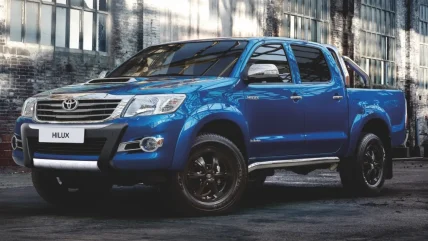
The first generation of Toyota Hilux appeared in 1967, building on the success of working versions of the legendary Land Cruiser, being noted for its domination of the Far East and Australian markets.
The Hilux quickly gained a reputation for toughness and reliability – Toyota UK being quick to highlight the fact that even BBC’s TopGear could not kill one and christened it Invincible. This expanded its profile and along with special Arctic Trucks-inspired editions has rather skewed the model’s true values – in the UK at least. At the same time it has seen its crown – if not taken, then certainly tilted – first by the now departed Mitsubishi L200 and latterly Ford’s Ranger as the go-to pick-up of desire. Against this backdrop, its humble (if proven) 2.4-litre diesel soldiered on until the 2020 facelift. This ushered in a raft of new kit but most importantly the 2.8-litre version of the D4-D common rail turbo diesel, used in the Land Cruiser.
The Hilux – despite its name – has always been more workhorse than lifestyle wannabe and the larger engine certainly helps here. While 204hp is still not a huge amount, at the time Ford dropped its excellent 3.2-litre lump from the Ranger in favour of the Transit’s 2.0-litre bi-turbo, Toyota seized the initiative to offer a big thumping four-pot. Torque delivery is excellent, there’s 500Nm of it but only if you opt for the automatic gearbox – which you should as the manual is rather ponderous. The 4WD remains as a part-time set up including low ratio. The double cab version offers 1,520mm of load length, (800mm more for the single cab – if you can find an example!) a width of 1,645mm at maximum, with sides and tailboard height being 480mm. The loading height off the ground is some 860mm and payloads vary between 1,050kgs and 1,110 kgs – for a basic trim version with manual ’box. The single cab will tow the maximum allowable 3,500kg, but a double cab can only drag 3,200kg.
Overall the Hilux is 5,330mm long, on a near 3.1m wheelbase, some 1,860mm in the beam, standing at 1,810mm high. That does not translate into a lot of headroom; the Hilux has always given the feeling of sitting in a family car on stilts, rather than the loftier stance you get in a Defender or Land Cruiser along leafy lanes. The automatic transmission is a boon here or in town. The low first gear in the manual is eaten up too quickly when unladen, causing unsympathetic drivers to take off in second, to the detriment of the clutch.
The Hilux offers four trim variants: Active, Icon, Invincible and Invincible-X. The Active starts the ball rolling with 17in steel wheels (ideal for off-road tyres) mechanical rear differential lock manual A/C and adaptive cruise control. Icon models add headlamp washers, sidesteps and 8in infotainment screen, ‘active’ (limited-slip) rear differential and reversing camera. The Invincible has all that plus, 18in alloy wheels, LED headlights, climate control, heated front seats and all-round parking sensors. You’ll need the Invincible X to get satnav, voice control and keyless entry whilst it also adds leather seats, wheel arch flares and a nine-speaker sound package. The Hilux may not head the class anymore, but it’s still the tough workhorse you expect.
Plus points
1) Strong and very reliable
2) Good off-road ability
3) Flexible warranty and servicing options
Minus points
1) Moderate equipment levels
2) Payload / towing trails rivals
3) No engine choices
Second-hand buys
|
Version |
Plate |
Year |
Mileage |
Price ex.VAT |
|
2.8D4-D D/Cab Invincible |
21 |
2021 |
25,800 |
£34,990 |
|
2.8D4-D D/Cab Invincible |
71 |
2021 |
27,200 |
£35,995 |
|
22.8D4-D D/Cab Invincible |
22 |
2022 |
10,100 |
£36,998 |
|
2.8D4-D D/Cab Invincible |
23 |
2023 |
1,100 |
£39,750 |
|
2.8D4-D D/Cab Invincible |
73 |
2023 |
38 |
£47,999 |





